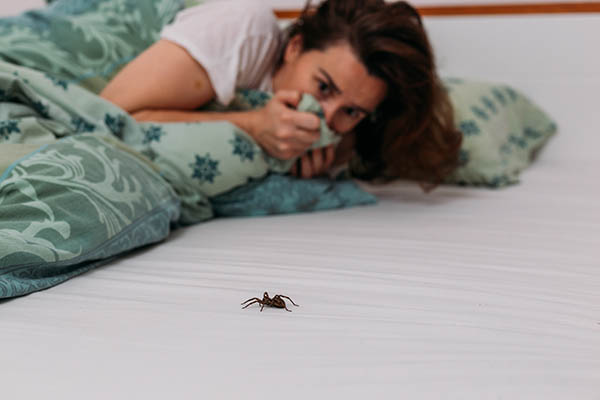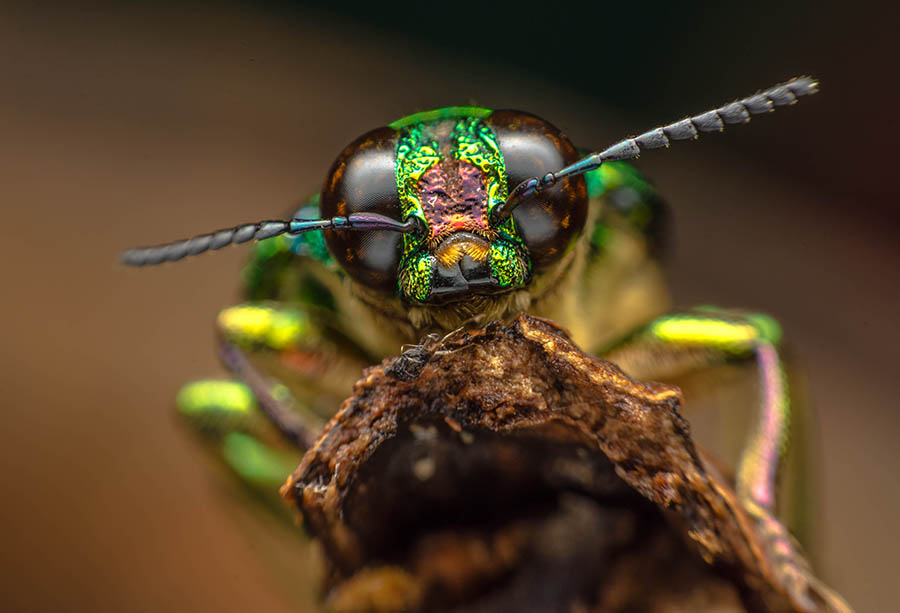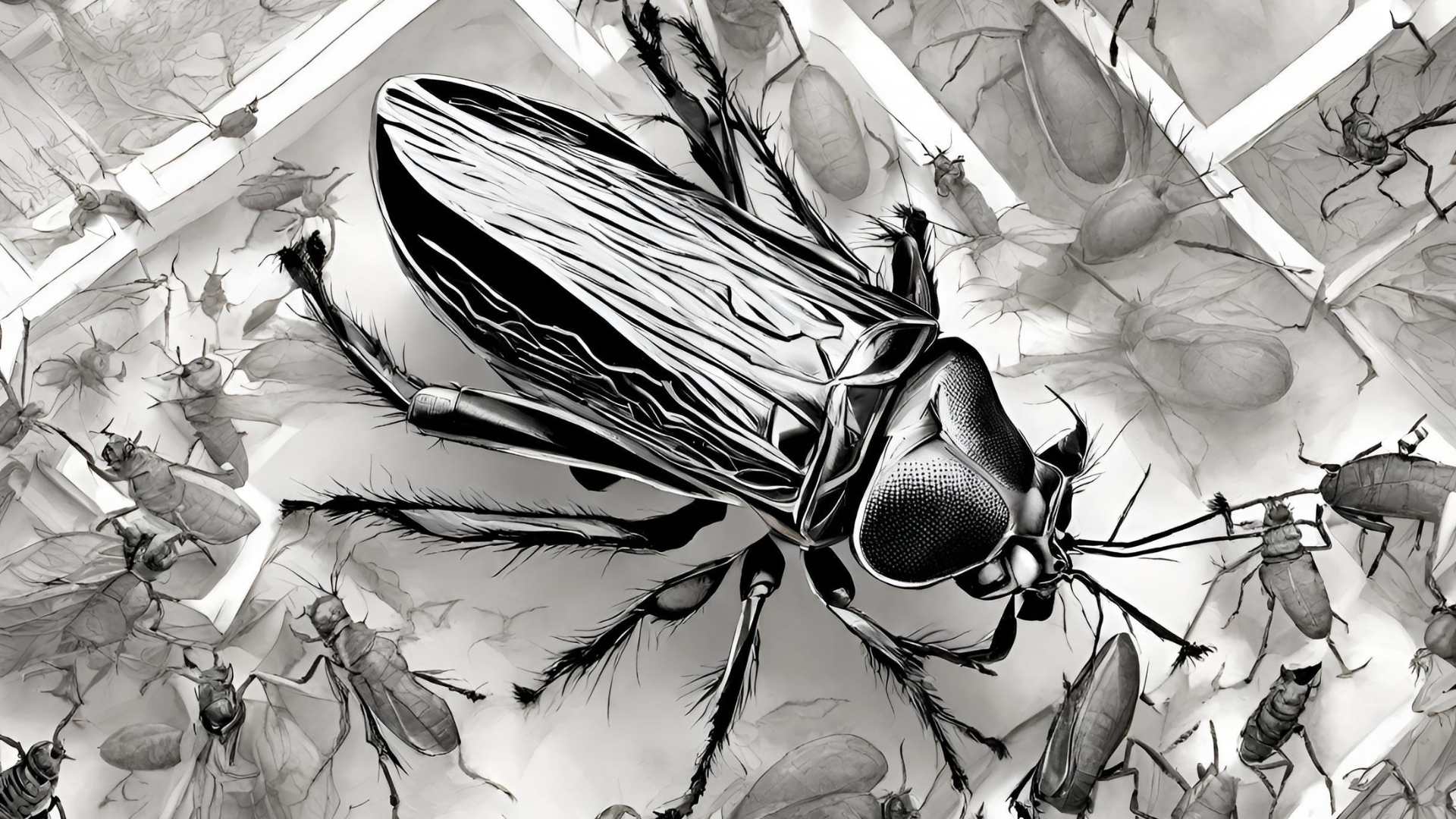Ever wonder why those tiny creepy crawlies freak you out so much? Why even the sight of a butterfly fluttering by can send shivers down your spine? The truth is, your fear of insects likely stems from something much deeper. You didn’t just wake up one day with an irrational aversion to bugs. Rather, there are a few possible explanations for how this phobia developed and took hold. The good news is, once you understand the underlying cause of your discomfort around insects, you can start to overcome it. If you don’t want to, Cure-All Pest Control can help ensure your run-ins with roaches and other creepy crawlies are kept to a minimum with a comprehensive pest control service.
So, let’s delve into the root causes of your bug phobia, or let’s make your day-to-day easier by organising a pest inspection.
 What Is Entomophobia? Understanding the Fear of Bugs
What Is Entomophobia? Understanding the Fear of Bugs
Entomophobia is the fear of insects and bugs. If the sight of a creepy crawly critter
sends you into a panic, you likely suffer from this phobia.
Difference between Entomophobia and Arachnophobia
Arachnophobia and entomophobia are both specific phobias related to different types of animals, but they involve different fears. It’s not uncommon for people to have both phobias and sometimes certain creatures seem more frightening than others. If you’re scared of things like grasshoppers, butterflies and moths, chances are you have entomophobia. If your fears have eight legs, you have arachnophobia.
Arachnophobia:
Arachnophobia is the fear of spiders and other arachnids, such as scorpions and ticks.
People with arachnophobia often experience intense anxiety, fear, and distress when they encounter spiders or even think about them.
The fear may be triggered by the appearance, movement, or the idea of being bitten by a spider.
Arachnophobia is one of the most common specific phobias, and it can lead to avoidance behaviour, panic attacks, and other symptoms when confronted with spiders.
Entomophobia:
Entomophobia is the fear of insects in general.
Unlike arachnophobia, which specifically focuses on arachnids like spiders, entomophobia encompasses a wide range of insects, such as ants, bees, cockroaches, and butterflies.
People with entomophobia may be afraid of insects due to their appearance, the potential for stings or bites, or the idea of insects crawling on them.
Like arachnophobia, entomophobia can also lead to avoidance behaviours and significant distress when encountering insects.
What causes this fear?
For many, it develops in childhood after a traumatic experience with an insect, like being bitten or stung. The memory of this frightening event stays with you, and your fear generalises to all bugs. In other cases, entomophobia is learned from parents or caretakers who model a fearful reaction.
This fear can significantly impact your life. You may avoid the outdoors, certain rooms in your home, and some foods altogether. The good news is entomophobia is treatable. Exposure therapy, where you gradually encounter insects in a controlled setting, is very effective. As you face your fear in small steps, your anxiety lessens.
Other techniques like relaxation training, cognitive restructuring, and systematic desensitisation can also help. With practice and patience, you can overcome your fear of creepy crawlies. Start by looking at photos of insects, then progress to videos. Have a friend show you bugs in a container from a distance.
Gradually, get closer to the bugs. This gradual exposure, at your own pace, will help you stay calm and lessen feelings of fear and distress. Conquering entomophobia will free you to enjoy all life has to offer, without worry of our tiny co-inhabitants. With time and effort, you can beat this phobia for good!
Common Causes of Bug Phobia and Disgust Towards Insects
A lot of us freak out at the sight of bugs and insects. If you’re one of those people with a bug phobia, there are a few possible reasons why these creepy crawlies give you the heebie jeebies:
Early Childhood Experiences
Your fear of insects may stem from a traumatic experience with bugs as a kid. Maybe you were swarmed by bees or bitten by spiders. These kinds of events can stick with you and cause a lasting phobia.
Disgust Sensitivity
Some people are just more sensitive to disgusting sights and sounds. The way insects look and move triggers feelings of revulsion. Their spindly legs, creepy wings and icky antennae freak you out. The thought of bugs crawling on you makes your skin crawl.
Learned Behaviour
You may have developed a fear of bugs from watching family members or friends react negatively to insects. Their anxiety and avoidance of bugs rubbed off on you from an early age. This kind of learned behaviour is common but the good news is, it can be unlearned.
Feeling out of Control
For some, a fear of insects stems from a general anxiety over things you can’t control or predict. You never know where bugs might turn up or what they might do. This uncertainty triggers a panicky feeling that’s hard to shake.
The roots of bug phobias are often complex. But awareness of the underlying causes can help in overcoming your fear and disgust towards insects. With the right treatment, your days of jumping on chairs at the sight of spiders may be numbered!
Fear of germs
Insects are also carriers of germs and diseases. Because of this, an insect phobia can also compound a germ phobia. If you find that you’ll throw out an entire loaf of bread because a fly touched it, or you can’t stop thinking about what an insect is carrying, your phobia likely stems from a fear of germs as well.
The Evolutionary Roots of Fearing Bugs and Other Creepy Crawlies
Many people experience a visceral fear of insects and other creepy crawlies. This phobia likely has its roots in human evolution.
Our Ancestors Had Good Reason to Fear Bugs
For our early human ancestors, insects posed a real threat. Bites and stings could lead to injury or disease, and swarms of locusts or other pests could destroy food sources. Those with a healthy fear of bugs were more likely to avoid them, survive, and pass on their genes.
Over countless generations, this evolved into an innate wariness of insects and arachnids in many humans. Even though most bugs we encounter today are harmless, that evolutionary imprint remains. The sight of a spider or cockroach can trigger our fight or flight reflex, releasing adrenaline and cortisol to prepare us to escape danger.
Some degree of bug phobia is normal and even helpful. It makes us cautious around potentially dangerous insects and motivates us to keep our homes free of pests. But for those with an extreme fear of insects, this evolutionary mechanism has become overly sensitive. Mere insects that pose no real threat can seem terrifying. Treatment like exposure therapy, where people are gradually exposed to bugs in a controlled setting, can help desensitise this overactive response.
Understanding the evolutionary basis of fears and phobias can help make them feel less irrational. Our anxiety around insects isn’t a personal failing or flaw, but rather a natural human instinct that developed for good reason. Recognising this can be the first step to overcoming an excessive fear of bugs.
How Media Portrayals Can Contribute to Entomophobia
Media often portrays insects in a negative light which contributes to many people’s fear of bugs, known as entomophobia. Horror movies, TV shows, books, and video games frequently depict insects as dangerous, disease-ridden pests that swarm, infest, and attack.
Movies and TV
Many sci-fi and horror films show insects, especially spiders, as menacing mutants that hunt humans. Movies like Aliens, IT and plenty of horror movies use insects or insect-like features to trigger disgust in the audience. While these portrayals are fictional, they still feed into our innate dislike of insects and revulsion towards their unfamiliar features like lots of legs, creepy antennae and strange movements.
Media Hype
News reports also tend to focus on the negative with sensational headlines about “invasions” of insects like locusts, mosquitoes or stink bugs. They report on diseases spread by insects and warn about agricultural damage. While these issues are important to report, the hyped up language and constant stream of scare stories contribute to the perception of insects as threatening pests. Some people may start to believe all insects are dangerous or disease-ridden, even though the reality is most are harmless or even beneficial to the environment.
The media’s influence on entomophobia is powerful because we tend to believe what we see and hear, especially at a young age. Portraying insects in a more balanced way could help alleviate anxiety for those with a fear of bugs. Focusing on their important role in ecosystems, and showing their natural beauty and diversity may help transform perceptions over time. Understanding the root causes of fears and phobias is the first step towards overcoming them.
Overcoming Your Fear of Bugs: Tips and Strategies
Overcoming your fear of bugs will take time and patience. Start with these effective strategies:
Exposure Therapy
The best way to overcome a phobia is through gradual exposure to the source of your fear. Start by looking at photos of insects, then progress to videos. When you’re comfortable, observe live bugs in a controlled setting, like an insectarium. This helps desensitise you in a gradual way.
Learn About Insects
Educate yourself about insects, their role in the environment, and which ones are harmless to humans. The more you know, the less threatening they will seem. Most insects want nothing to do with people and will not attack unprovoked.
Stay Calm
When you encounter an insect, remain calm and still. Do not make sudden movements, scream or swat at it. This is more likely to provoke an aggressive response. Take a few deep breaths to stay composed. Remind yourself that the insect means you no harm.
Address Irrational Thoughts
Try to identify irrational thoughts about insects and replace them with more realistic ones. For example, replace “All insects are dangerous” with “Most insects will not harm me if I don’t provoke them.” Challenge negative beliefs with facts and rational thinking.
Seek Professional Help if Needed
If your fear of insects is severe and limiting your life, consider seeing a therapist. A therapist can provide counselling and guidance for overcoming your phobia through techniques like exposure therapy, cognitive restructuring and anxiety management skills. With time and effort, you can overcome your fear of bugs and live more freely.
Remove Bugs from the Equation With Cure-All Pest Control
Not all bugs are bad, but there are some that can be harmful to your home and health. Check out our services page for bugs you absolutely do not want in your home. When you know what pests are harmful, the others don’t seem so bad. Things like ladybugs, butterflies, bees and even some types of wasps and spiders play an important role in ensuring the micro-ecosystem in your yard stays in check.
If you find that natural balance is out of wack and one particular insect population has become an infestation, then it’s time to remove them from your environment completely. Regular pest control treatment is the most effective solution.
Schedule Regular Exterminator Visits
Hire an exterminator to spray your home, especially entry points like doors and windows, every few months. Professional pest control companies use strong chemicals that effectively eliminate bugs and keep them out of your living space for an extended time. The exterminator can also treat areas where bugs like to hide, such as basements, attics, garages, and sheds.
Seal Any Cracks or Crevices
In between exterminator visits, do your own pest prevention by sealing up any cracks or holes in foundations, siding, roofs, and entryways to your home. Use caulk, weatherstripping, door sweeps, and repair damaged screens to eliminate access points for insects. Bugs can enter through openings as small as 1cm, so be thorough in your search for potential entryways.
Store Food in Airtight Containers
Bugs are attracted to food smells and leftovers. Keep your kitchen clean and free of crumbs. Store all human and pet food in airtight containers, especially overnight. Take out the trash regularly and rinse recyclables to avoid attracting pests. A clean home is an inhospitable environment for insects and rodents.
Use Natural Repellents
Some essential oils naturally repel insects. Apply a few drops of eucalyptus, citronella, lavender or peppermint essential oil around doorways, windows, attics, basements and any areas where bugs may enter. You can also plant insect-repelling plants like basil, catnip, citronella grass, lavender, rosemary, and thyme outside entryways and open windows. Their strong fragrance deters bugs in a natural and eco-friendly way.
Following these pest prevention steps will give you peace of mind knowing that insects have little opportunity or motivation to share your living space. Over time, your fear should subside as your encounters with creepy crawlies become few and far between.
Conclusion
So there you have it, the reasons behind your bug phobia. Chances are, your fear stems from a combination of these factors – whether it was an unpleasant childhood experience, seeing scary insects in movies and on TV, or simply inheriting a predisposition to fear creepy crawlies from your parents and grandparents. The good news is, phobias are treatable. With exposure therapy and cognitive techniques, you can overcome that irrational fear and stop those bugs from bugging you. Next time an insect buzzes by, try not to freak out. Remind yourself that most bugs mean you no harm. Take a few deep breaths and let it pass on by. Your bug phobia doesn’t have to rule your life, you’ve got this! Stay strong and reclaim your power – because those bugs are more scared of you than you are of them.fear-of-bugs-header





